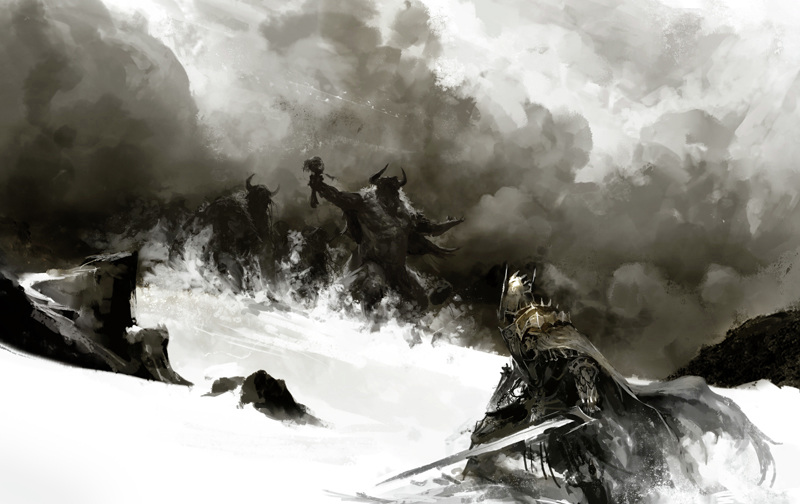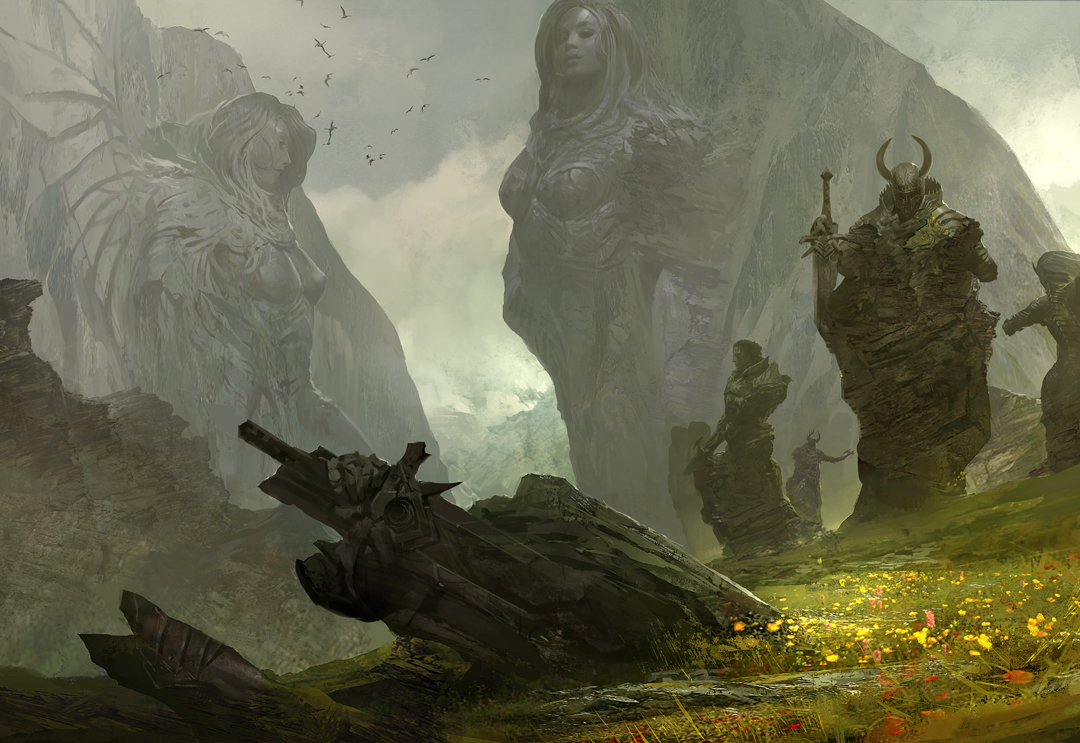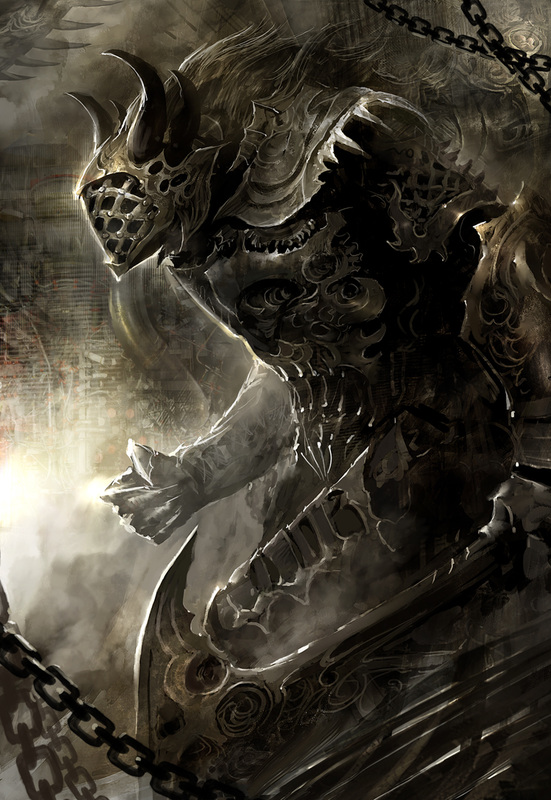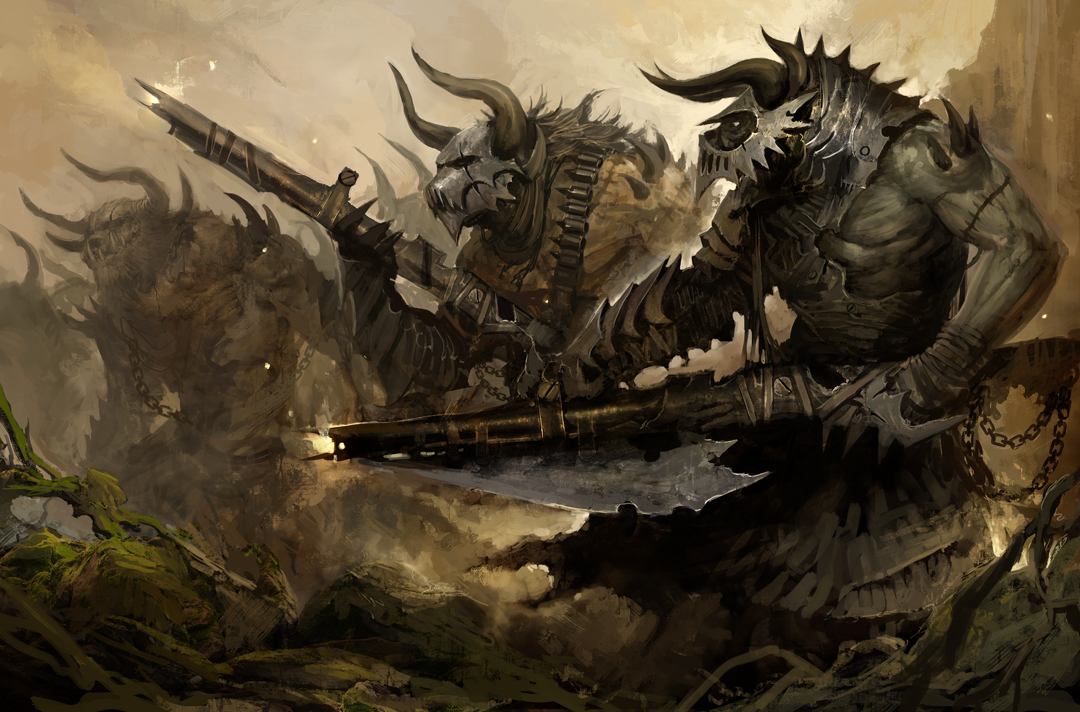|
|
Post by zurajai on Dec 21, 2015 1:35:07 GMT
On the Almur
A treatise on the Northern Giants
by Efendi Osman Cevik Dogukan

The Descent of the Almur - Painting by Leonardo Franco de Lucente, Lucentian Artist and Explorer
Preamble It was from this very lectern that I write this treatise now that I first saw the Almur with my own two eyes; the horned giants from the Far North, seemingly so beastial in appearance, came down from the mountains in their vast hosts to sweep aside all that opposed them. I, Osman Cevik Dogukan, second son of Bey Ibrahim Celik Dogukan, write this treatise with intent to shed light on the enigmatic Almur out of a desire to educate all those who speak the Survaekom tongue for it seems none have dared attempt such a feat before me. It is then my Duty onto Aed to perform such action so that these new inhabitants of our shared lands, as the feyborn Sylphs before them, can be seen in the light of civilization rather than villainized as barbarians and conquerors from distant lands. The information I share with you comes from first hand sources, acquired through interview or my own research into the extensive texts of the Almur. |
|
|
|
Post by zurajai on Dec 22, 2015 0:12:58 GMT
History of the Almur
In the Shadow of Giants - Painting by Leonardo Franco de Lucente depicting his idyllic vision of the ancient Almuric Homeland The history of the Almur is separated into six distinct epochs of varying length and historical note. First in the Archaic Period, the earliest point in Almuric history that consisted of early hunter-gatherer societies and the very beginnings of the Almuric social consciousness that led to the development of early ritual behavior and animism. It was in this period that the idea of the unknown deity was cemented into Almuric religion and culture forever and would be the greatest legacy of the period left on Almur society. Although conflict was semi-common during this time period, inter-tribal warfare was rare and disputes were usually solved with threat of violence rather than blows.
The second distinct epoch in Almur history is known as the Early of Classical period, a time noted for the abandoning of earlier hunter-gatherer societies in order to embrace more sedentary lifestyles in proto Hearth-homes. It was in this period that the practices of metallurgy, masonry, and agriculture became far more prevalent as permanent, stone-hewn settlements developed around volcanic fissures and cave networks that supported the growing reliance on agriculture over nomadic gathering of resources. It was during this time that inter-tribal warfare became the norm as the abundance of resources was reduced by a growing population. Metallurgy, which had been rare even in the late Archaic Period, led to advancements in weapons and armor that allowed for a scale of warfare previously unprecedented in the Almuric North. Small, professional warbands loyal to the nobles of their Hearth-Homes raided into lands of hated rivals to take captives in the form of slaves, resources, and the perceived honor of warfare. The period came to an end with the rise of the High Kings of the Almur and the creation of the Almur Empire.
With the founding of the Almur Empire the Classical Period gave way to the Middle or Imperial Period, an epoch known as the Golden Age to Almuric scholars as it held the period of the most growth and the highest reaching power of the Almuric Empire and the Almur race. The conquest of the Almuric North by the soon to be Naryur, the High King of the Almur, Yuron Szekeres. The direct descendants of Yuron ruled the Almuric Empire for nearly five hundred years before the death of the last Szekeres Naryur at the hands of an unknown and unrecorded enemy and the line was past up the kinship to the closest known relation of the time, passing into the hands of Ur Durand Antall, whom migrated his entire Hearth-Home to the capital upon receiving the title Naryur and ascending to the throne. The Antall line of Kings ruled the Empire unbroken for nearly a millenium before the lines eventual collapse from civil war among two claimants to the throne. With the end of the Antall line came the last line of the High Kings when a daughter of the union of the Antall line and a lesser Hearth-Home ascended to the throne. She would become famed as the greatest Empress the Almur ever had, perhaps one of if not the greatest rulers in their history, as Naryur Virag Szaboyar-Szekeres. Her line would reclaim the name Szekeres and would bare it to the very end of the Almur history.
With a powerful monarchy and the religion and culture of the Almur concrete and unchanging, the Imperial Period saw the greatest growth in technology, the arts, and warfare. It was in this time that blackpowder was first discovered and the resource was quickly put to use in rituals, entertainment, and warfare. The firearms of the early Imperial Period were simplistic yet effective and the further evolution of these weaponry led to the forefathers of the firearms used in the modern era. The development of firearms, as well, led to the idea of less destructive forms of warfare when it came to the physical form that left a great deal more individuals casualties of war with wounds that would be easily repaired in the afterlife. It was during this time that the necropoli of the Almur began and reached their height as Hearth-Holds build vast, hollowed out artificial mountains to bury their petrified dead in to await the discovery of the creator. An era of relative peace gripped the Empire even as the sun began to set on the Almuric realm.
By far the shortest of all the epochs, the Late or Cataclysmic Period came about during an increase in volcanism in the region and led to the complete collapse of the Almuric Empire. Within the first year the Naryur, Zoltan Szekeres, was killed during a massive earthquake that destroyed the capital and shook the Empire to it's core. Zoltan, having never had children, left the Empire without an heir and a mad scramble by all those with claim to the thrown ensued. The Granite Crown, the symbol of Imperial authority said to have been carved from the ivory of Yuron Szekeres himself and the very stone upon which his first conquests were held, had been shattered into nearly a dozen pieces, each one claimed by an individual claimant of the throne so as to cement their rule. Thirty years of civil war followed as the Empire of the Almur was smote to the ground by the earth itself and the death blow came from its very own hand.
Following the ravages of the Cataclysm the once great empire of Yuron Szekeres was in ruins. With a great loss of life now marring their race and the few resources left unable to sustain the massive population still extant, many of the survivors of the now shattered holds joined in following their Hearth-Holds into the tundra in search of new homes. The Modern or Horde period had begun. The individual hordes, led by the descendants of those original claimants to the throne of Szekeres now titled Kezur, wandered aimlessly in all directions; some to the east, towards the sea, while others went west and south into the great unknown while the most desperate went north in search of their ancient home. Occasionally these hordes would cross paths again, either coming into conflict or trading before parting ways. In this time several pieces of the Granite Crown were gathered by the hordes and piece by piece they were reforged, leaving the hordes with a crown that mirrored their people; barely reforged and missing far too many pieces for their own good.
The Gospodars, led by Yurok Szekeres, originally come from the now legendary Hold of Gospvarog and have held together under the rule of Yurok for the last century and a half. They have found themselves in the lands now lost to the Survaekom Empire, the so-called "North". It is here that Yurok sees a home for his people and a place where his son, Kharok, and all his descendants to come can finally call home.
|
|
|
|
Post by zurajai on Dec 22, 2015 0:17:41 GMT
The Almuric Search They Who Forge - Illustration by Kallisto Decumio, Juturna Corps Watch Captain; Art based on initial interactions with the Almur and shows a far more bestial visage than is true.
The Almur, among their many oddities, follow a form of monolatrism that claims the existence of a creator god who is unknown to the Almur themselves; He-Who-Forged-The-World. HWFTW can be referred to by many names, many non-gender specific, referring to a group, or even more eccentric forms of reference. The Almur priests, the Seers and Farseers, determined that at the beginning of the world a being or group of beings created the Almur and, as all Almur children are, they were born blind and thus unable to look upon the face of their creator/s. Instead, the Almur cling to the ideals of ancestor worship leading all the way back to the original Kithancestors, the animal-forebears from which the Almur were originally designed. It is the main, driving idealogical concept of Almuric Paganism to ascertain the true identity of He-Who-Forged-The-World through exploration and question; a prophecy yet unfulfilled. For many generations during the rise and golden-era of the Almur it was generally believed that the answers would either come to them or were unnecessary and that oneness with reality and self-discovery could be attained without searching for their creator. During the Cataclysm that rocked the Almuric Empire and indeed, well after, it became a common belief among the Seers that the world had shook the Almur race from their slumber for ignoring their creators and their wandering is enforced upon them till they find the true face of their creator.
With their religion so tied to creation it is without a wonder that the Almur hold such practices as artisanry, masonry, and metallurgy with high esteem. The Artificers of the Almur race are viewed with great respect and religious deference as they craft the tools, armaments, and homes of the Almur peoples. A breed all their own, the Artificers keep to themselves and jealously hide their knowledge, passing it on to select and rare individuals who become their apprentices. However, when it is time for an Artificer to leave his workshop and bestow one of his or her great works upon his kin it is done with great love and passion in their hearts, offering the item as if giving up a child to someone they know will truly care for it. This comes into play most evidently when individuals grant the bodies of the deceased to Artificers to be crafted into items, memento-mori in the truest sense as weapons, jewelry, and other such trinkets are carved from the ivory of the dead. Through this process the family of the deceased may hold close to them parts of their beloved ancestors in remembrance of their deeds and their continued affect on the living.
Due to the nature of their search Almuric Paganism has picked up the traits of religions it has passed by and taken a fancy to, considering such things as small insights into HWFTW and stepping stones on the path of divine discovery. As such, it is difficult to truly convert an Almur from their belief systems as their core-idealogy is as strong and unyielding as the rock from which they were hewn by their creator. However the same can be said for the reverse as the Almur have little to share when it comes to true beliefs and as their religion molds itself naturally with their movements across the world it becomes more and more difficult to discern what is theirs and what was picked up on the way. The Almur afterlife is one such aspect that has remain unchanged, however, as nothing learned has been enough to shake their fervent belief in the realm of the dead. Intrinsic to their petrification upon death, it is believed that an Almur who is relatively undamaged in war will pass into the afterlife unscathed when He-Who-Forged-The-World has been found, free to live a life of luxury with their creator and ancestors. Those more thoroughly damaged, however, such as suffering from dismemberment or disemboweling, are feared to bring their wounds with them and will suffer in the afterlife if left unchecked. The solution, in a strange act of cultural mutilation, is to carve up the petrified ivory corpse of the individual and use the pieces to create items of great value and sentiment for the owner. It is believed that upon the discovery of the creator that He-Who-Forged-The-World will see the deeds of that ancestor through the items he or she was forged into and would be able to remake the spirit in the afterlife, whole and free of suffering and pain.
|
|
|
|
Post by zurajai on Dec 22, 2015 0:20:53 GMT
Culture of the Almur Beasts of Metal and Smoke - Illustration by Kallisto Decumio, Juturna Corps Watch Captain; Art based on initial interactions with the Almur and shows a far more bestial visage than is true.
The Almur have a rich culture that has been developed over several thousand years of history. Almuric culture is centered heavily around the idea of relations, both biological and social, that create powerful bonds and speak greatly to an individual Almur's standing in their society and their religion with four groupings of relation coming to the forefront; Kithband, Kinship, Hearth-Home, and Hold/Horde. According to the archaic religious practices of the Almur, an individual's Kith is determined by both blood and the individual's personality. When He-Who-Forged-The-World first created the Almur he did so following the general plans he had when making the animals of the world; as such, the first Almur to walk the earth bore the traits of the beasts that walked around them. Although many animals held import, several lines have stood the test of time and are considered to be the extant kithbands; Bear, Roc, Wolf, Rhino, Lion, Fox, and Whale. Although each Kith-ancestor has a name unto itself, they are often referred to simply as the animal itself. These kith-ancestors were known for social traits, such as the kindness and wroth of Bear, and such traits are now associated with those who belong to their Kith. Since so many years have passed and there are no pure lines, it is believed that the capability to be any of the Kithbands exists in the blood of individual Almur and thus it is up to their own personality to dictate their Kith. It is, indeed, a hot topic of discussion about a youth's Kith before the ceremony that determines their true Kithband and many a parent have been known to become infuriated upon learning their child does not take after them.
Kinship is far more clear as it is determined completely by blood. An Almur shares Kinship with both of his parent's bloodlines and such bonds are known to transcend generations with far off cousins coming to each other's aid simply due to the drop of blood they share. Kinship, of course, is a mark of pride to many Almur and it is common for a prideful Almur to cite his blood shared with kings of old and the lines of lords yet living. In the same vein of a Kinship, the idea of the Hearth-Home is based on what you are born into, to a certain extent. A Hearth-Home is the noble lineage in which an individual is born into or under, a Noble Household so to speak that all Almur either belong to or serve. Almur commoners hold it as a point of contention when discussing the Hearth-Home they belong to and will openly threaten and even come to blows with those of opposing and rival Hearth-Homes. With lives as long as Almur and collective memories far long, Hearth-Homes frequently hold long lasting and ever present blood feuds for slights both real or otherwise that have existed for generations or more. In ancient days long past multiple Hearth-Homes made up a Hold, one of the great mountain-cities of the Almuric Empire in the far north of the world. These holds were both political and social entities in which even the most hated Hearth-Home rivals would band together to defend against outside invaders. Since the cataclysmic destruction of their homeland and no Holds left to speak of the Almur have changed their political organization into Hordes, wandering bands led by a single Ruler who leads the multiple Hearth-Homes in search of new lands to call home.
Despite the collapse of the Almuric Empire much of the culture has been retained through the oral tradition, written records, and highly ritualized behavior of their shamanistic Seers and through their trials and tribulations their resolute Warrior-Culture of the old Almuric Empire has reigned supreme. Back in the days of the Old Empire the wonders of blackpowder had been discovered at their apex and had been put to use in a number of ways, most notably in the form of firearms. Blackpowder weapons were famously popular within the Empire as weapons of true skill and, indeed, a warriors worth was highly reliant on one's ability to effectively service, maintain, and accurately use their firearm. Although not considered a measure of a warrior's skill to the degree the degree guns were, melee weapons in the form of gunstock clubs, maces, axes, polearms, and blades were used frequently as the expectation of close quarters violence was one ever present in the highly dense and urbanized cities of the Almur. Although far less prevalent now, military orders consisting of warriors all belonging to the same Kithband were incredibly famed in the Old Empire for their skill with their bladed firearms whilst in full plate armor. The Brotherhood of the Roc, indeed, remains to this day with the Horde of the Gospodars, the heirs a long heritage of warriors who fled with this particular Horde from the lands of their ancestors so many years ago.
A peculiar ritual of Almur culture is that of the Potlatch, a yearly gathering held by one of the Hold/Horde's Hearth-Homes where all members of the Hold/Horde are invited. The host, the Patriarch of the Hearth-Home, will provide food, drink, the venue and the entertainment with the well-earned wealth and resources of the Hearth-Home. The celebration will consist of sports, oration, feasting, music and religious ceremony concluding with the ceremonial charitable give-away of as much personal wealth the Patriarch and his household can offer. These offerings will be given to those families in need and the other Hearth-Homes, especially rivals. To give more is to be seen as not only generous but powerful; only a healthy and strong Hearth-Home could possibly part with so much wealth. In doing so the Patriarch gains prestige and influence for both himself and his Hearth-Home and challenges his rival to outdo him in the following year, upping the ante with each successive Potlatch. If their rival fails, then, to match them in the following year than a great deal of personal and household honor will be lost and the "winning" Hearth-Home will be able to hold the victory over their rival for generations to come. |
|
|
|
Post by Johnathafek on Dec 17, 2019 16:54:18 GMT
Я считаю, что Вы не правы. Могу это доказать.
---
не.не для меня скачать лицензию fifa 15, скачать fifaconfig для fifa 15 и <a href=http://15fifa.ru/raznoe-fifa-15/32-zvuk-fifa-15-mezhdunarodnye-kommentatory-skachat.html>fifa 15 комментаторы скачать</a> скачать fifa manager 15 торрент бесплатно
|
|







